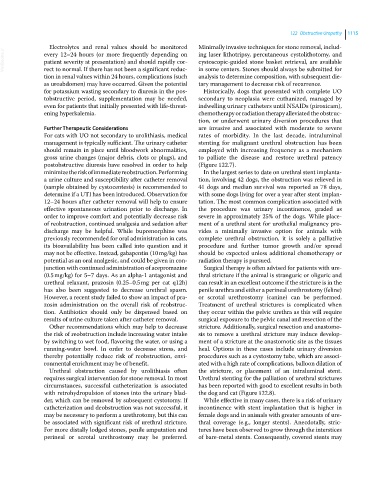Page 1177 - Clinical Small Animal Internal Medicine
P. 1177
122 Obstructive Uropathy 1115
Electrolytes and renal values should be monitored Minimally invasive techniques for stone removal, includ
VetBooks.ir every 12–24 hours (or more frequently depending on ing laser lithotripsy, percutaneous cystolithotomy, and
cystoscopic‐guided stone basket retrieval, are available
patient severity at presentation) and should rapidly cor
rect to normal. If there has not been a significant reduc
analysis to determine composition, with subsequent die
tion in renal values within 24 hours, complications (such in some centers. Stones should always be submitted for
as uroabdomen) may have occurred. Given the potential tary management to decrease risk of recurrence.
for potassium wasting secondary to diuresis in the pos Historically, dogs that presented with complete UO
tobstructive period, supplementation may be needed, secondary to neoplasia were euthanized, managed by
even for patients that initially presented with life‐threat indwelling urinary catheters until NSAIDs (piroxicam),
ening hyperkalemia. chemotherapy or radiation therapy alleviated the obstruc
tion, or underwent urinary diversion procedures that
Further Therapeutic Considerations are invasive and associated with moderate to severe
For cats with UO not secondary to urolithiasis, medical rates of morbidity. In the last decade, intraluminal
management is typically sufficient. The urinary catheter stenting for malignant urethral obstruction has been
should remain in place until bloodwork abnormalities, employed with increasing frequency as a mechanism
gross urine changes (major debris, clots or plugs), and to palliate the disease and restore urethral patency
postobstructive diuresis have resolved in order to help (Figure 122.7).
minimize the risk of immediate reobstruction. Performing In the largest series to date on urethral stent implanta
a urine culture and susceptibility after catheter removal tion, involving 42 dogs, the obstruction was relieved in
(sample obtained by cystocentesis) is recommended to 41 dogs and median survival was reported as 78 days,
determine if a UTI has been introduced. Observation for with some dogs living for over a year after stent implan
12–24 hours after catheter removal will help to ensure tation. The most common complication associated with
effective spontaneous urination prior to discharge. In the procedure was urinary incontinence, graded as
order to improve comfort and potentially decrease risk severe in approximately 25% of the dogs. While place
of reobstruction, continued analgesia and sedation after ment of a urethral stent for urothelial malignancy pro
discharge may be helpful. While buprenorphine was vides a minimally invasive option for animals with
previously recommended for oral administration in cats, complete urethral obstruction, it is solely a palliative
its bioavailability has been called into question and it procedure and further tumor growth and/or spread
may not be effective. Instead, gabapentin (10 mg/kg) has should be expected unless additional chemotherapy or
potential as an oral analgesic, and could be given in con radiation therapy is pursued.
junction with continued administration of acepromazine Surgical therapy is often advised for patients with ure
(0.5 mg/kg) for 5–7 days. As an alpha‐1 antagonist and thral stricture if the animal is stranguric or oliguric and
urethral relaxant, prazosin (0.25–0.5 mg per cat q12h) can result in an excellent outcome if the stricture is in the
has also been suggested to decrease urethral spasm. penile urethra and either a perineal urethrostomy (feline)
However, a recent study failed to show an impact of pra or scrotal urethrostomy (canine) can be performed.
zosin administration on the overall risk of reobstruc Treatment of urethral strictures is complicated when
tion. Antibiotics should only be dispensed based on they occur within the pelvic urethra as this will require
results of urine culture taken after catheter removal. surgical exposure to the pelvic canal and resection of the
Other recommendations which may help to decrease stricture. Additionally, surgical resection and anastomo
the risk of reobstruction include increasing water intake sis to remove a urethral stricture may induce develop
by switching to wet food, flavoring the water, or using a ment of a stricture at the anastomotic site as the tissues
running‐water bowl. In order to decrease stress, and heal. Options in these cases include urinary diversion
thereby potentially reduce risk of reobstruction, envi procedures such as a cystostomy tube, which are associ
ronmental enrichment may be of benefit. ated with a high rate of complications, balloon dilation of
Urethral obstruction caused by urolithiasis often the stricture, or placement of an intraluminal stent.
requires surgical intervention for stone removal. In most Urethral stenting for the palliation of urethral strictures
circumstances, successful catheterization is associated has been reported with good to excellent results in both
with retrohydropulsion of stones into the urinary blad the dog and cat (Figure 122.8).
der, which can be removed by subsequent cystotomy. If While effective in many cases, there is a risk of urinary
catheterization and deobstruction was not successful, it incontinence with stent implantation that is higher in
may be necessary to perform a urethrotomy, but this can female dogs and in animals with greater amounts of ure
be associated with significant risk of urethral stricture. thral coverage (e.g., longer stents). Anecdotally, stric
For more distally lodged stones, penile amputation and tures have been observed to grow through the interstices
perineal or scrotal urethrostomy may be preferred. of bare‐metal stents. Consequently, covered stents may

